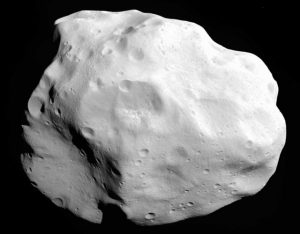
– click to enlarge
Asteroids are rocky objects orbiting the Sun – particularly those found within the boundary of the orbit of Jupiter – with sizes ranging between tens of meters to almost one thousand kilometres in diameter. Since 2006, the International Astronomical Union (the IAU) have classed asteroids as small Solar-System bodies (SSSBs), along with other similarly-sized objects (such as centaurs, comets and trans-Neptunian objects), although they are also known as minor planets or planetoids.
The first asteroid to be discovered was Ceres – named after the Roman goddess of agriculture – discovered in 1801, by Giuseppe Piazzi. Ceres is the largest object in the asteroid belt and has now been classified by the IAU as a dwarf planet, since it is roughly spherical in shape, due to its own gravity. Most asteroids are much more irregular in shape, however.
The word asteroid means “star-like”, since they appeared merely as point sources of light, like stars, through the telescopes of the early nineteenth century, although they were detectable because their positions moved night by night, against the fixed background stars.
Asteroid Populations
Over one million asteroids have now been discovered, the majority of which are found within the main asteroid belt between the orbits of Mars and Jupiter. It is likely that this population of asteroids is a remnant of the Sun’s protoplanetary disk and would have coalesced to form a planet, were it not for the disruptive gravitational influence of Jupiter.
It is estimated that there are many millions more asteroids, larger than a few tens of meters, within the asteroid belt. Any objects smaller than this are traditionally referred to as meteoroids.
Other large populations of asteroids also exist, such as the Trojans, which orbit at Lagrangian points roughly 60 degrees in front of or behind the orbit of a planet. There are thought to be almost as many Jupiter-Trojan asteroids as main-belt asteroids.
Near-Earth asteroids
Near-Earth asteroids are asteroids whose orbits around the Sun take them close to Earth. Objects whose orbits intersect with that of the Earth are known as Earth-crossing asteroids. The orbits of thousands of these objects are being tracked, and various strategies have been proposed to deal with any large asteroids that pose a risk of collision with the Earth.
On 26 September 2022, NASA’s DART – Double Asteroid Redirection Test – spacecraft was deliberately crashed into the asteroid Dimorphos. The mission was designed as a first test run to see whether it would be possible to successfully divert the path of a dangerous Earth-threatening asteroid through a kinetic impact.
Dimorphos is an S-type asteroid (see Types of Asteroid, below), with a mean diameter of 170 metres, that is in a binary system with its larger companion Didymos – hence the words “double asteroid” included in the mission’s acronym. Although Dimorphos posed no threat to Earth, by comparing the orbit of Dimorphos around Didymos before and after DART’s impact, it should be possible to determine how much its orbit has changed. A follow-up mission, Hera, is intended to reach the double asteroid system in 2026, to further study the results of the impact.
Types of Asteroid
The following main asteroid classifications have been identified, although some asteroids are classified using a combination of letters when they have properties of more than one type:
C-group asteroids – dark carbonaceous asteroids. Around 75 per cent of asteroids are of this type.
In the Tholen classification, these are split into the following types based mainly on observed spectroscopic differences: C-type, B-type, F-type, G-type.
S-type asteroids – stoney or silicaceous asteroids. Around 17% per cent of asteroids are of this type.
X-group asteroids – in the Tholen classification, these include the following asteroid types:
M-type asteroids – metallic asteroids, usually composed of nikel-iron mixed with small amounts of stone. Large asteroids, can have enough gravity for their constituents materials to have separate out according to their mass. Metallic asteroids are believed to be the remnants of the metallic cores of larger asteroids, subsequently fragmented by impacts. Iron meteorites are thought to be M-type asteroids that have impacted the Earth.
E-type asteroids – similar to M-type asteroids but with an albedo or 0.3 or greater (i.e. a surface that is more reflective to light).
P-type asteroids – dark and reddish in appearance, possibly consisting of silicates and carbon.
The following smaller classes by population, also exist: A-type, D-type, T-type, Q-type, R-type, V-type.
The Small Main-Belt Asteroid Spectroscopic Survey (SMASS) of 1,447 objects in 2002, introduced several new classifications based on spectra.
Asteroid Names and Numbers
An asteroid, or other minor planet, is assigned a sequential identifying number after its orbit has been precisely determined and it has been observed several times over at least four oppositions. Once this is done, an asteroid can then be given an optional name by its discoverer.
When an asteroid or other minor planet is first discovered, it is assigned a provisional designation consisting of the year of discovery followed by a letter indicating the half month in which it was discovered, from A to Y (I is not used). This is followed by a second letter, from A to Z (again skipping I), and subscript number indicating the order of its discovery within the half month – the number indicating how many times the sequential letter designation has been cycled through. E.g. the asteroid provisionally named 2004KB1 would have been the 27th minor planet discovered in the period between 16 and 30 May, 2004.
Related Objects
The Centaurs are asteroid-like objects found beyond the orbit of Jupiter. Centaurs, generally, have surface ice that would sublime to form a cometary tail if they had closer orbits to the Sun.
Kuiper belt objects, and comets (originating mainly from the Kuiper belt and the Oort cloud), are more icy in composition than asteroids, although the distinction is blurred between these objects, centaurs and asteroids in terms of composition.
Since 2006, the IAU has classified all such bodies – asteroids, centaurs, comets and trans-Neptunian objects – as small Solar-System bodies.
Missions to Asteroids
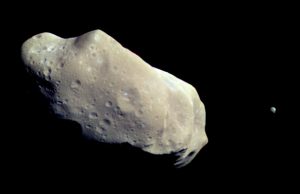
– click to enlarge
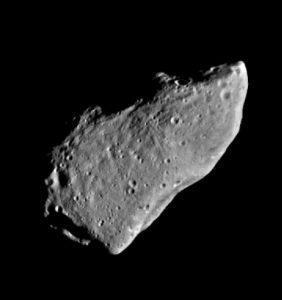
– click to enlarge
The first asteroid visited by a spacecraft was 951 Gaspra, which was imaged by the Galileo probe, in 1991, on its way to study Jupiter and its moons. Galileo also imaged 243 Ida in 1993, discovering a small moon orbiting the asteroid, which was named Dactyl after a nymph from Greek mythology.
NEAR Shoemaker
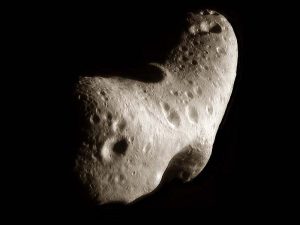
– click to enlarge
NASA’s Near Earth Asteroid Rendezvous – Shoemaker (NEAR Shoemaker) was the first mission to specifically target an asteroid. Near was launched in 1996 and was renamed NEAR Shoemaker, shortly afterwards, to honour Eugene Shoemaker (the co-discoverer of Comet Shoemaker-Levy 9) who died in 1997.
NEAR Shoemaker was sent to orbit the near-Earth asteroid 433 Eros, before touching down on its surface on 12 February 2001. NEAR also conducted a fly-by of asteroid Mathilde on its way to Eros.
Data from NEAR suggests that EROS is similar in density to the Earth’s crust and could contain large quantities of gold and platinum.
Hayabusa

– click to enlarge
In November 2005, the Japanese space probe Hayabusa (Japanese for Peregrine Falcon) landed on asteroid 25143 Itokawa collecting a sample from the surface for return to Earth. The sample’s composition was found to match that of chondrite meteorites, containing the minerals olivine, pyroxene, plagioclase and iron sulphide.
Rosetta
On its way to rendezvous with comet 67P/Churyumov–Gerasimenko, the European Space Agency’s Rosetta spacecraft flew past both asteroid 2867 Šteins, in September 2008, and asteroid 21 Lutetia, in July 2010 (See main image of asteroid 21 Lutetia, above).
Dawn
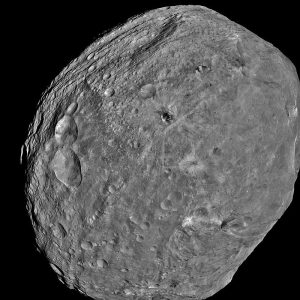
– click to enlarge
NASA’s Dawn spacecraft orbited the asteroid 4 Vesta, between 2011 and 2012, before moving on to orbit the Dwarf Planet Ceres. Dawn discovered gullies on the surface of Vesta that could possibly have been made by flowing liquid water.
Top 10 largest known asteroids:
1 Ceres
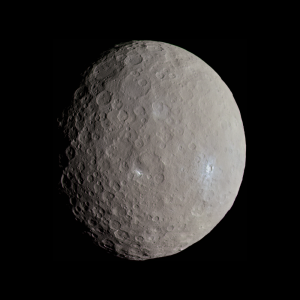
– click to enlarge
Ceres is the only asteroid classed as a dwarf planet by the International Astronomical Union (IAU). Ceres accounts for approximately one third of the mass of the asteroid belt.
Ceres is named after the Roman goddess of agriculture.
Mean diameter: 946 metres – 28% the diameter of the Moon
Mean distance from Sun: 2.766 Astronomical Units (AU)
Class: G
Discovered: 1 January, 1801
2 Pallas
Mean diameter: 544 metres – 16% the diameter of the Moon
Mean distance from Sun: 2.773 AU
Class: B
Discovered 28 March, 1802
4 Vesta
Vesta is an unusually bright asteroid occasionally visible from Earth to the unaided eye.
Mean diameter: 525 metres
Mean distance from Sun: 2.362 AU
Class: V
Discovered: 29 March, 1807
10 Hygiea
Mean diameter: 431 metres
Mean distance from Sun:
Class: C
Discovered: 12 April, 1849
704 Interamnia
Mean diameter: 326 metres
Mean distance from Sun: 3.062 AU
Class: F
Discovered: 2 October, 1910
52 Europa
N.B. not to be confused with the Jovian moon of the same name.
Mean diameter: 315 metres
Mean distance from Sun: 3.095 AU
Class: C
Discovered: 4 February, 1858
511 Davida
Mean diameter: 289 metres
Mean distance from Sun: 3.168 AU
Class: C
Discovered: 1903
87 Sylvia
Mean diameter: 286 metres
Mean distance from Sun: 3.485 AU
Class: X
Discovered: 16 May, 1866
65 Cybele
Mean diameter: 273 metres
Mean distance from Sun: 3.439 AU
Class: C
Discovered: 8 March, 1861
15 Eunomia
Mean diameter: 268 metres
Mean distance from Sun: 2.643 AU
Class: S
Discovered: 29 July, 1851
For a longer list of large asteroids, visit: en.wikipedia.org/wiki/List_of_exceptional_asteroids#Largest_by_diameter